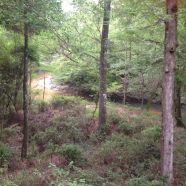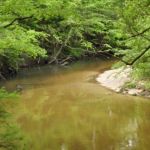A Garden in the Woods
So, just how does one “garden” in the woods? But for vague childhood memories of a tiny victory garden toward the end of World War II, the only gardens I even knew were tended by others . . . and woods weren’t gardens. I was to learn otherwise.
I never contemplated the meaning of gardening in the woods until I bought some “wilderness”—thirteen acres of it on the high bluffs of the upper Tchefuncte River in St. Tammany Parish, Louisiana, in 1970. My plan was to pitch a tent. I ended up camping for the next six years every weekend and holiday that I could afford to take from my hectic law practice in downtown New Orleans. Thus began my own unanticipated spiritual journey into the blessings to be found being at one with nature. Some say I became the nature boy.
On that bright and cool April morning in the late 1960s, mentally preparing for a deposition I was to take in Bogalusa in the case of a young girl who had been killed in a tragic accident, something unexpected happened as I crossed the new Causeway bridge across Lake Pontchartrain. On the north shore, the land seemed from another world. Dogwoods, azaleas, and redbuds were in bloom, native iris filled roadside ditches, and towering pines loftily waved their purple and white wisteria-laden branches like ladies dancing in full color dress . . . a promising purity of spring in the fresh scented ozone breeze.
Disdaining land-clearing machinery, I instead cleared small areas and river paths with ditch knife, machete, and hand pruner. Being a city transplant, even though I thought we were being sensitive, I would not have known then, particularly if not in bloom, whether I was hacking wild camellia, silverbell, sourwood tree, passion flower or trumpet vine, Carolina lily, or rare flame flower . . . or some plain-Jane plant that happened to be just what some amphibian, mammal, bird, or insect needed to survive. They live here too!
Slowly, I learned the plants and trees, and kept a log of the wildflowers as they bloomed, and began to feel a sense of “gardening” in the woods, in a natural garden to be preserved. Eventually, I kept the ledger for nearly twenty years, so I could predict what should bloom in what month.
This was during the days when the Cold War was at its height, with concerns of bombs and dangerous buttons to be pushed. I sometimes fantasized survival possibilities if some undetermined ecological or war-caused holocaust would just spare these woodsy little bluffs and the river. Could I survive if I had only the river for water, and mushrooms, berries, edible roots, and leaves, as well as birds and mammals so surprisingly abundant to eat? Could man survive even today on the Creator’s natural bounty? Right here in southeast Louisiana? On the bluffs of a clean little artesian-fed stream?
One day, on a long walk along the junglelike, meandering river path, a visiting French friend stopped in her tracks and exclaimed, “Mon Dieu, vous avez ici les champignons des chanterelles!” (You have chanterelle mushrooms here!). One could say I was interested . . . but dubious. (I remembered ordering years ago . . . for $10! . . . a tiny plate of chanterelles in a Paris café, but . . . wild?) Only after a year, having purchased several mushroom books and studying them carefully, did my friend and I then tenuously taste a tiny portion of the buttery fungi (“You go first!”). I’m not a big risk taker when it comes to eating “wild” and, after all, they came from the forest floor not the grocery store! Today, chanterelles are still our late summer treat, growing among moss patches along the river. Delicious and I’m still alive! And, by Parisian prices, we may pick $300 worth for one August supper!
Blackberries, long a favorite in the repertoire of mother’s famous cobblers, were plentiful in summer, as were other less familiar but just as edible, incredible berries we encountered. I knew little else about other edible and medicinal native plants.
As for animals, the woods had squirrel, rabbit, opossum, beaver, river otter, fox, coyote, and deer, and there were dove, quail, and turkey one reckoned would make a fine roast or meat pie. We’ve seen tiny fresh water shrimps and mussels in the river that feed many of the animals, and sometimes we’d catch pan perch, bass, or catfish for a meal.
I’ve learned to tend garden a different way: by leaving an old, fallen tree to rot on the ground where it may host myriad mushrooms, moss, anoles, and skinks; by walking along a wild flower path and raking off a handful of blazing star, Indian pink, or meadow beauty seed to cast in the air (just to help Mother Nature a bit); or by mowing some areas only once or twice a year to allow flower and native grass seed pods to mature and drop to the ground to ensure thicker stands of various colors the next blooming season; and by helping all these native plants by taking out Chinese tallow, privet, and other harmful foreign invasives.
Using no fertilizers, mowing only a section, and then only occasionally stacking brush and branches into habitat options for animals: it all adds up to not only an easier task than trying to manicure thirteen acres; I’m sure Mother Nature prefers her Creation to mine!
Today, I garden when I can call the names of the various trees, animals, and flora and tell them I’m glad they’re here. And, Mon Dieu, they are all welcome here.
Author’s Note
Shortly before I wrote this piece for South Writ Large, and after searching for seven years for the right people to continue my bed and breakfast/cabin rental/nature retreat, Blaine and Loretta Dubose came to stay at Little River Bluffs for their fourteenth anniversary (having not visited since their first), and are now, quite unexpectedly to them and to me, the proud new owners and innkeepers. I will continue to live on the grounds as Innkeeper Emeritus, as the new owners carry on my vision and “take it to the next level.” More photos of the river and land can be viewed at www.littleriverbluffs.com.









Delightful, even though it makes me feel like an ignoramus regarding mother earth. My father and I had an acre garden that I grew up working, but this makes it obvious how different that vegetable patch was from the experience of nature David Campbell has enjoyed.
As someone proud to be his friend, I am also pleased at how this example of his writing skill reveals his exuberant personality
Just left Louisiana and this makes me remember a “natural” garden I left in North Carolina. Learned the hard to just watch for a year and see what happens before you cut. Great essay, thanks.
It is thanks to my dear uncle that I have gone on to be a horticulturalist specializing in ecological restoration and revegetation. I spent my childhood visiting Little River Bluffs and unbeknownst to me then, that natural garden was the seed that would germinate into a life-long career caring for the Australian environment. Thank you Uncle David, thank you with all my heart.
Cherished memories. Seeing the tent grow into a wonderful house, experiencing chantarelles fresh from the soil, swimming in the cold clear river and warm pond, Most of all, the caring friendship. Thanks so much for so many great times over so many years. Time may pass but the memories still glow.